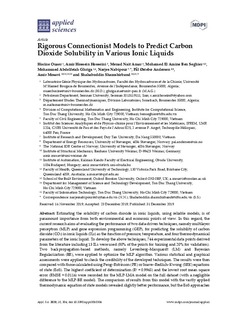| dc.contributor.author | Ouaer, Hocine | |
| dc.contributor.author | Hosseini, Amir Hossein | |
| dc.contributor.author | Amar, Menad Nait | |
| dc.contributor.author | Ben Seghier, Mohamed El Amine | |
| dc.contributor.author | Ghriga, Mohammed Abdelfatah | |
| dc.contributor.author | Nabipour, Narjes | |
| dc.contributor.author | Andersen, Pål Østebø | |
| dc.contributor.author | Mosavi, Amir | |
| dc.contributor.author | Shamshirband, Shahaboddin | |
| dc.date.accessioned | 2020-01-07T14:50:06Z | |
| dc.date.available | 2020-01-07T14:50:06Z | |
| dc.date.created | 2019-12-27T18:45:16Z | |
| dc.date.issued | 2020-01 | |
| dc.identifier.citation | Ouaer, H., Hosseini, A.H., Amar, M.N. et al. (2019) Rigorous Connectionist Models to Predict Carbon Dioxide Solubility in Various Ionic Liquids, Applied Sciences, 10(1) | nb_NO |
| dc.identifier.issn | 2076-3417 | |
| dc.identifier.uri | http://hdl.handle.net/11250/2635161 | |
| dc.description.abstract | Estimating the solubility of carbon dioxide in ionic liquids, using reliable models, is of paramount importance from both environmental and economic points of view. In this regard, the current research aims at evaluating the performance of two data-driven techniques, namely multilayer perceptron (MLP) and gene expression programming (GEP), for predicting the solubility of carbon dioxide (CO2) in ionic liquids (ILs) as the function of pressure, temperature, and four thermodynamical parameters of the ionic liquid. To develop the above techniques, 744 experimental data points derived from the literature including 13 ILs were used (80% of the points for training and 20% for validation). Two backpropagation-based methods, namely Levenberg–Marquardt (LM) and Bayesian Regularization (BR), were applied to optimize the MLP algorithm. Various statistical and graphical assessments were applied to check the credibility of the developed techniques. The results were then compared with those calculated using Peng–Robinson (PR) or Soave–Redlich–Kwong (SRK) equations of state (EoS). The highest coefficient of determination (R2 = 0.9965) and the lowest root mean square error (RMSE = 0.0116) were recorded for the MLP-LMA model on the full dataset (with a negligible difference to the MLP-BR model). The comparison of results from this model with the vastly applied thermodynamic equation of state models revealed slightly better performance, but the EoS approaches also performed well with R2 from 0.984 up to 0.996. Lastly, the newly established correlation based on the GEP model exhibited very satisfactory results with overall values of R2 = 0.9896 and RMSE = 0.0201. | nb_NO |
| dc.language.iso | eng | nb_NO |
| dc.publisher | MDPI | nb_NO |
| dc.rights | Navngivelse 4.0 Internasjonal | * |
| dc.rights.uri | http://creativecommons.org/licenses/by/4.0/deed.no | * |
| dc.subject | CO2 solubility | nb_NO |
| dc.subject | ionic liquids | nb_NO |
| dc.subject | carbon dioxide | nb_NO |
| dc.subject | multilayer perceptron | nb_NO |
| dc.subject | machine learning | nb_NO |
| dc.title | Rigorous Connectionist Models to Predict Carbon Dioxide Solubility in Various Ionic Liquids | nb_NO |
| dc.type | Journal article | nb_NO |
| dc.type | Peer reviewed | nb_NO |
| dc.description.version | publishedVersion | nb_NO |
| dc.rights.holder | © 2019 by the authors | nb_NO |
| dc.subject.nsi | VDP::Technology: 500 | nb_NO |
| dc.source.volume | 10 | nb_NO |
| dc.source.journal | Applied Sciences | nb_NO |
| dc.source.issue | 1 | nb_NO |
| dc.identifier.doi | 10.3390/app10010304 | |
| dc.identifier.cristin | 1764014 | |
| dc.relation.project | Norges forskningsråd: 230303 | nb_NO |
| cristin.unitcode | 217,8,11,0 | |
| cristin.unitname | Institutt for energiressurser | |
| cristin.ispublished | true | |
| cristin.qualitycode | 1 | |

